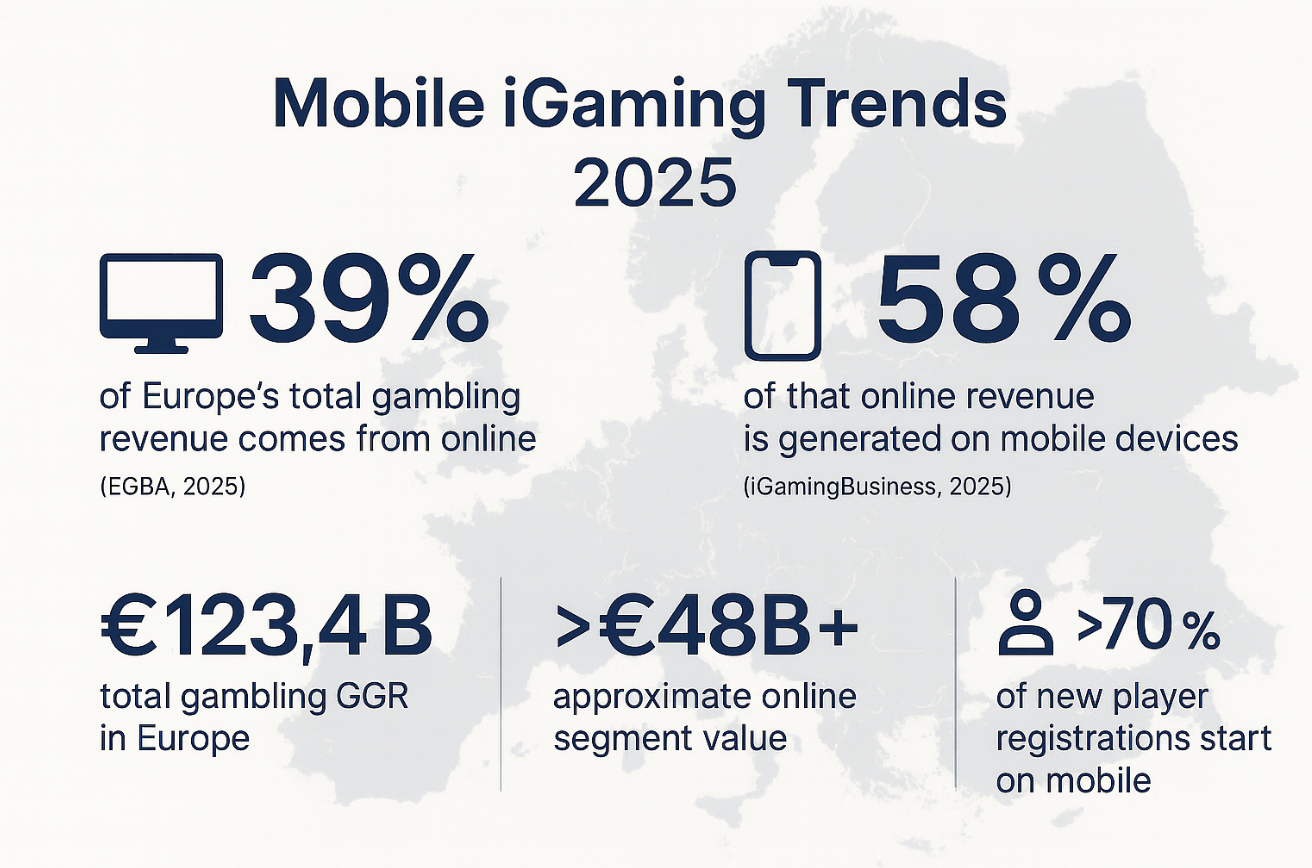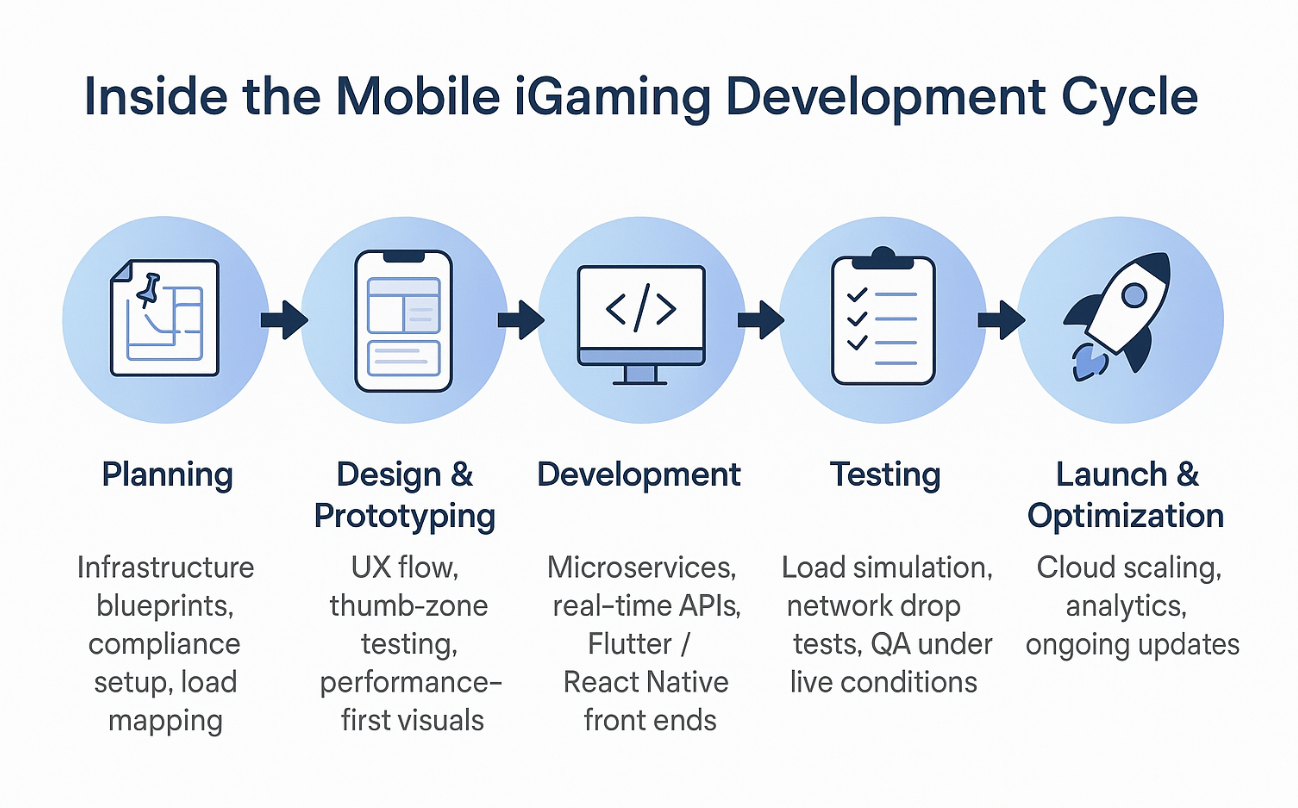In 2025, mobile has become the main environment for iGaming, accounting for most player activity across regulated markets. According to the European Gaming and Betting Association (EGBA), online gambling now makes up 39% of Europe’s total gambling revenue, with more than 58% of that activity occurring on mobile devices (iGamingBusiness, 2025).

This rapid shift has made mobile the true core of iGaming. Players expect instant access, seamless interfaces, and reliable performance whether they’re spinning slots, placing bets, or joining live tables. For operators, that means mobile development is no longer about offering convenience but about creating the entire environment where play, payments, and loyalty happen.
This article breaks down how modern iGaming platforms are built for mobile: the features that keep players engaged, the technologies driving smooth performance, and the process behind bringing these systems to market.
Evolving User Expectations: What Players Demand from Mobile iGaming
Players no longer see iGaming apps as niche products, rather, they compare them to the best apps on their phone. When users are used to banking, streaming, and shopping instantly, they expect the same from betting or casino platforms. That shift has made user experience the real measure of success in mobile iGaming.
Personalized but Predictable
Modern users want the app to know them — their favourite games, usual stake sizes, preferred payment methods — but not to constantly move things around. The best platforms keep the interface consistent while quietly adapting content and offers in the background.
Frictionless Flow
Most players jump between different activities — a few spins, a quick bet, a check on results — all in short bursts. They won’t tolerate lags or reloads between these actions. Smooth transitions and fast responses define how players judge quality now. As Google’s UX research shows, even small delays can cause over half of users to drop off before a page or app fully loads, and that same impatience defines modern iGaming behaviour.
Short-Session Design
Mobile users often play in spare moments, not hour-long sessions. That’s why top apps focus on instant value, such as quick logins, fast access to favourites, and gameplay that loads right away. Every unnecessary screen or tap risks losing attention.
Trust Built Into the Interface
In a space where money moves constantly, design is what communicates safety. Clear confirmations, visible balances, progress indicators, and “pending” tags for withdrawals or bets make players feel secure without extra explanation. Cluttered screens or hidden feedback quickly erode trust.
Handling Real-World Conditions
Connectivity drops, app switching, background interruptions have become daily realities. Good apps don’t punish players for them. They save progress, reconnect automatically, and clearly show when the connection is restored. That kind of stability quietly earns loyalty.
Designed for Real Use
It’s easy to forget that most players use one hand, in motion, often on smaller screens. Well-designed apps adapt to this: key buttons within thumb reach, readable text, and simple navigation that doesn’t require precision tapping. It’s small details like these that make the difference between a playable app and a frustrating one.
According to a recent ResearchGate study, UX design choices directly influence retention and conversion rates in mobile apps, proving that usability isn’t cosmetic; it’s what keeps players coming back.
These evolving expectations are what drive the technical backbone of modern iGaming. Meeting them takes more than good design; it requires infrastructure built for speed, stability, and scale.
Building the Backbone: Technology and Development in Mobile iGaming
Behind every seamless mobile experience is a well-planned development process supported by the right technology. In iGaming, where milliseconds and reliability define success, each stage, from concept to post-launch, relies on specific tools and systems working together.

- Discovery and Planning: Defining the Foundations
Before writing a line of code, teams map out technical and user priorities, such as speed, uptime, and compliance.
- Analytics & Planning Tools: Product analytics platforms like Amplitude or Mixpanel help model expected player behaviour and load.
- Infrastructure Blueprints: Cloud architecture is outlined early to ensure scalability and regulatory compliance across regions.
- Compliance Integration: APIs for KYC and payment providers are selected based on jurisdiction — essential groundwork for later builds.
- Design and Prototyping: Shaping User Flow
This stage defines how users experience every interaction (registration, play, payments) before development starts.
- Design Systems: Tools like Figma or Sketch ensure consistency across hundreds of screens and device sizes.
- UX Testing Frameworks: Early usability testing with prototypes identifies friction points that would otherwise emerge post-launch.
- Performance Consideration: Lightweight UI animations and modular layouts are planned to minimize app size and startup time.
- Development: Turning Logic into Experience
This is where architecture and front-end frameworks bring the product to life.
- Front-End Frameworks: Flutter and React Native dominate for cross-platform builds; some studios still use native Swift (iOS) or Kotlin (Android) for ultra-smooth animations and GPU-heavy gameplay.
- Backend Architecture: Microservices split payments, user accounts, and game logic into independent modules, reducing downtime and allowing rapid updates.
- Real-Time Infrastructure: WebSockets and gRPC enable millisecond updates for live betting and tournaments.
- Cloud Deployment: AWS or Google Cloud environments provide global load balancing and auto-scaling, which are vital for traffic spikes during events.
- Testing and Optimization: Proving Stability
Before launch, every build faces real-world conditions — poor connections, multitasking, and sudden loads.
- Load Testing: Tools like JMeter simulate thousands of concurrent players to measure server response and latency.
- Network Simulation: QA teams test on unstable 3G/4G connections to ensure the app handles dropouts gracefully.
- Security Audits: Automated vulnerability scans and manual code reviews protect data flow and payments.
- Launch and Continuous Improvement
Post-launch, the focus shifts to optimization and user retention.
- Monitoring and Analytics: Datadog, Firebase, or AppDynamics track performance, crashes, and behaviour patterns in real time.
- AI-Driven Personalization: Machine learning models recommend games, bonuses, or bet types based on player history.
- A/B Testing: New features are gradually rolled out and measured for conversion and engagement impact.
If all this sounds like a puzzle — that’s because it is. Every strong mobile iGaming platform is a precise mix of technology, timing, and user understanding. Our LenGreo team brings these elements together from the very start, turning complex requirements into seamless experiences that perform under real-world pressure.
Smart Growth: How to Retain Players and Scale Without Compromise
Retention in mobile iGaming isn’t about holding attention once; it’s about earning it again every day. Players stay engaged when the experience keeps evolving, not just expanding. The best-performing apps build momentum through small, consistent updates: fresh tournaments, event-driven content, and seamless personalization that keeps the platform feeling alive without overwhelming users.
At the same time, personalization has moved beyond recommendations. Modern systems quietly adapt to each player’s rhythm by surfacing the right content, bonuses, and reminders based on real-time data. It’s an ongoing feedback loop between the user and the product: every action informs the next experience. When done right, this kind of relevance feels invisible, yet it’s the foundation of long-term loyalty.
Scaling introduces its own challenge — doing all of this without breaking what already works. Growth means new markets, payment systems, and player volumes, yet the user shouldn’t feel the strain. That’s where smart architecture and modular systems pay off. Platforms built on flexible components and cloud infrastructure expand fluidly, maintaining the same responsiveness whether serving one region or a global audience.
But growth isn’t just technical; it’s cultural. Teams that treat optimization as a constant process, not a reaction to churn, sustain stronger results. They iterate on player feedback, test small changes continuously, and refine without reinventing. Over time, this mindset turns maintenance into momentum.
Conclusion
In the end, sustained growth in iGaming doesn’t come from chasing players but from building systems and experiences that make them want to stay. The platforms that win are the ones that treat user experience, technology, and optimization as one continuous process, not separate stages.
That’s the mindset behind our work at LenGreo. We help iGaming companies design and refine mobile ecosystems that evolve alongside their audiences — fast, reliable, and always ready for what comes next. Because in this space, success isn’t just about keeping up with change, it’s about staying one step ahead of it.









